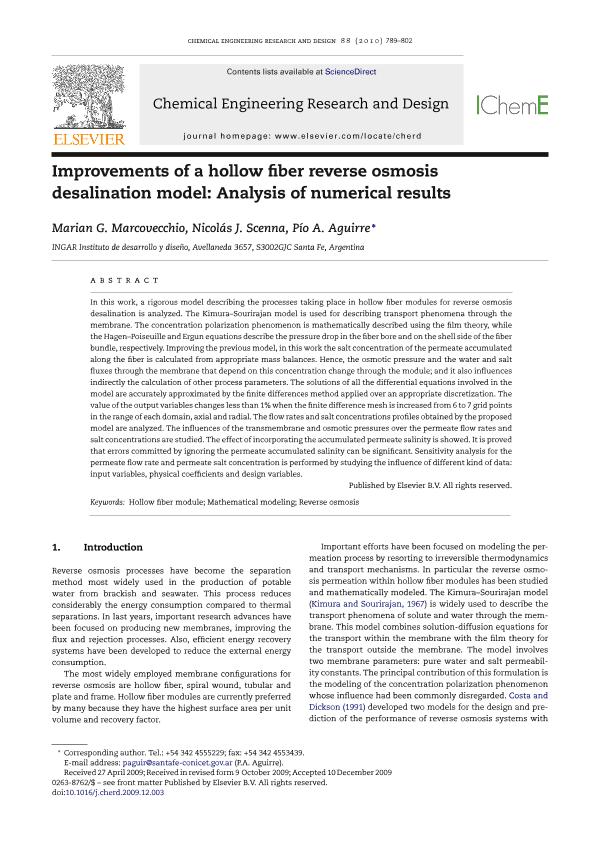Mostrar el registro sencillo del ítem
dc.contributor.author
Marcovecchio, Marian Gabriela

dc.contributor.author
Scenna, Nicolas Jose

dc.contributor.author
Aguirre, Pio Antonio

dc.date.available
2019-02-14T17:58:39Z
dc.date.issued
2010-07
dc.identifier.citation
Marcovecchio, Marian Gabriela; Scenna, Nicolas Jose; Aguirre, Pio Antonio; Improvements of a hollow fiber reverse osmosis desalination model: Analysis of numerical results; Elsevier; Chemical Engineering Research & Design; 88; 7; 7-2010; 789-802
dc.identifier.issn
0263-8762
dc.identifier.uri
http://hdl.handle.net/11336/70194
dc.description.abstract
In this work, a rigorous model describing the processes taking place in hollow fiber modules for reverse osmosis desalination is analyzed. The Kimura-Sourirajan model is used for describing transport phenomena through the membrane. The concentration polarization phenomenon is mathematically described using the film theory, while the Hagen-Poiseuille and Ergun equations describe the pressure drop in the fiber bore and on the shell side of the fiber bundle, respectively. Improving the previous model, in this work the salt concentration of the permeate accumulated along the fiber is calculated from appropriate mass balances. Hence, the osmotic pressure and the water and salt fluxes through the membrane that depend on this concentration change through the module; and it also influences indirectly the calculation of other process parameters. The solutions of all the differential equations involved in the model are accurately approximated by the finite differences method applied over an appropriate discretization. The value of the output variables changes less than 1% when the finite difference mesh is increased from 6 to 7 grid points in the range of each domain, axial and radial. The flow rates and salt concentrations profiles obtained by the proposed model are analyzed. The influences of the transmembrane and osmotic pressures over the permeate flow rates and salt concentrations are studied. The effect of incorporating the accumulated permeate salinity is showed. It is proved that errors committed by ignoring the permeate accumulated salinity can be significant. Sensitivity analysis for the permeate flow rate and permeate salt concentration is performed by studying the influence of different kind of data: input variables, physical coefficients and design variables.
dc.format
application/pdf
dc.language.iso
eng
dc.publisher
Elsevier

dc.rights
info:eu-repo/semantics/openAccess
dc.rights.uri
https://creativecommons.org/licenses/by-nc-sa/2.5/ar/
dc.subject
Hollow Fiber Module
dc.subject
Mathematical Modeling
dc.subject
Reverse Osmosis
dc.subject.classification
Otras Ingeniería Química

dc.subject.classification
Ingeniería Química

dc.subject.classification
INGENIERÍAS Y TECNOLOGÍAS

dc.title
Improvements of a hollow fiber reverse osmosis desalination model: Analysis of numerical results
dc.type
info:eu-repo/semantics/article
dc.type
info:ar-repo/semantics/artículo
dc.type
info:eu-repo/semantics/publishedVersion
dc.date.updated
2019-02-12T17:39:34Z
dc.journal.volume
88
dc.journal.number
7
dc.journal.pagination
789-802
dc.journal.pais
Países Bajos

dc.journal.ciudad
Amsterdam
dc.description.fil
Fil: Marcovecchio, Marian Gabriela. Consejo Nacional de Investigaciones Científicas y Técnicas. Centro Científico Tecnológico Conicet - Santa Fe. Instituto de Desarrollo y Diseño. Universidad Tecnológica Nacional. Facultad Regional Santa Fe. Instituto de Desarrollo y Diseño; Argentina
dc.description.fil
Fil: Scenna, Nicolas Jose. Consejo Nacional de Investigaciones Científicas y Técnicas. Centro Científico Tecnológico Conicet - Santa Fe. Instituto de Desarrollo y Diseño. Universidad Tecnológica Nacional. Facultad Regional Santa Fe. Instituto de Desarrollo y Diseño; Argentina
dc.description.fil
Fil: Aguirre, Pio Antonio. Consejo Nacional de Investigaciones Científicas y Técnicas. Centro Científico Tecnológico Conicet - Santa Fe. Instituto de Desarrollo y Diseño. Universidad Tecnológica Nacional. Facultad Regional Santa Fe. Instituto de Desarrollo y Diseño; Argentina
dc.journal.title
Chemical Engineering Research & Design

dc.relation.alternativeid
info:eu-repo/semantics/altIdentifier/doi/https://doi.org/10.1016/j.cherd.2009.12.003
dc.relation.alternativeid
info:eu-repo/semantics/altIdentifier/url/https://www.sciencedirect.com/science/article/pii/S0263876209003177
Archivos asociados
